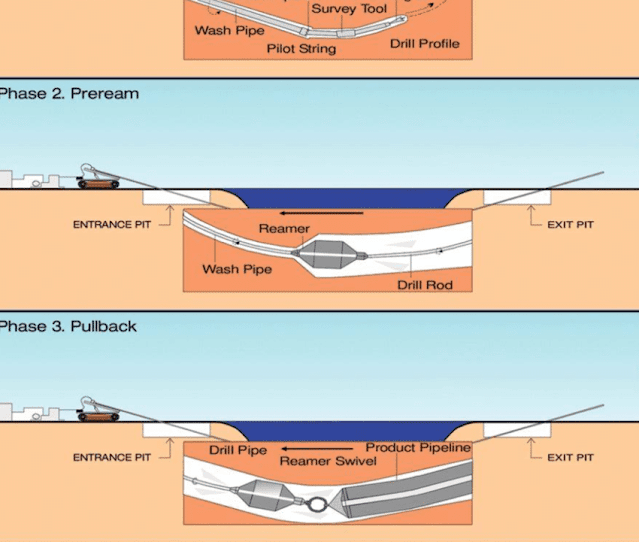What Are the Benefits of Using Horizontal Directional Drilling in Offshore Projects?
Offshore projects present unique challenges and opportunities in the realm of energy exploration and infrastructure development. One innovative solution that has gained significant traction in recent years is Horizontal Directional Drilling (HDD). This advanced technique offers a multitude of benefits, revolutionizing the way offshore projects are executed.
From enhancing environmental sustainability to improving project efficiency, the advantages of using HDD offshore are compelling.
So, here, today in this blog post, we delve deep into the myriad benefits that Horizontal Directional Drilling brings to offshore projects, showcasing its transformative potential in the marine environment.
Let’s dive into this blog to learn more.
Exploring the Benefits of Horizontal Directional Drilling in Offshore Projects
Offshore drilling operations are inherently complex, often involving harsh environmental conditions and stringent regulatory requirements. Traditional methods of offshore drilling, such as vertical drilling platforms, pose significant challenges in terms of environmental impact, operational safety, and cost-effectiveness. However, Horizontal Directional Drilling (HDD) has emerged as a game-changer in the offshore industry, offering a host of benefits that address these challenges effectively.
1. Minimized Environmental Impact:
Horizontal Directional Drilling (HDD) stands out in offshore projects due to its unparalleled capacity to mitigate environmental disturbances. Unlike conventional methods reliant on surface infrastructure, HDD's underground installation of pipelines and cables beneath the seabed significantly curtails habitat disruption, sedimentation, and the risk to marine biodiversity. This approach fosters sustainable offshore development by preserving delicate ecosystems while meeting energy and infrastructure needs. By minimizing surface disturbances and maintaining the integrity of marine habitats, HDD emerges as a responsible choice, aligning with conservation efforts and ensuring the long-term health of our oceans.
2. Enhanced Safety and Risk Mitigation:
In offshore operations, where safety is of paramount importance and the potential repercussions of mishaps can be dire, Horizontal Directional Drilling (HDD) emerges as a beacon of safety. By circumventing the necessity for surface drilling rigs, HDD significantly mitigates the risk of environmentally catastrophic events like oil spills. Operating from onshore or shallow-water platforms further shields personnel and marine life from potential hazards, fostering an environment conducive to safety. HDD's ability to minimize exposure to offshore risks enhances operational safety standards, underscoring its role in ensuring the well-being of all stakeholders involved while preserving the delicate balance of marine ecosystems.
3. Cost-Effectiveness and Efficiency:
Horizontal Directional Drilling or HDD not only delivers notable environmental and safety advantages but also drives substantial cost savings and operational efficiencies in offshore endeavors. By obviating the requirement for costly offshore drilling platforms and associated infrastructure, HDD slashes capital expenditures and operational costs inherent in conventional drilling techniques. Moreover, its capability to deploy multiple pipelines or cables from a singular onshore site amplifies project efficiency, accelerating deployment timelines and augmenting return on investment (ROI) for offshore developers. This streamlined approach not only trims project expenses but also enhances overall project economics, ensuring a more competitive edge in the offshore market while maximizing the utilization of resources and optimizing project outcomes.
4. Flexibility and Versatility:
Horizontal Directional Drilling (HDD) epitomizes adaptability, seamlessly accommodating diverse offshore environments spanning shallow-water regions, ecologically fragile zones, and densely populated marine territories. Its unparalleled flexibility enables meticulous navigation around obstacles like reefs, existing pipelines, and underwater structures, empowering developers to fine-tune route planning and mitigate project risks effectively. Whether tasked with deploying subsea cables to power offshore wind farms or laying pipelines for oil and gas exploration, HDD stands out for its unmatched versatility in executing offshore projects. This capability not only ensures the successful realization of complex offshore endeavors but also underscores HDD's pivotal role in fostering sustainable development practices while safeguarding marine ecosystems and minimizing environmental impact. As offshore projects evolve to meet growing energy demands, HDD remains an indispensable tool, offering developers the agility and precision needed to navigate the dynamic challenges of marine construction with confidence and efficiency.
5. Long-Term Reliability and Performance:
Offshore infrastructure faces relentless assaults from nature's elements, including powerful currents, corrosive seawater, and seismic disturbances. To thrive in such hostile environments, structures must exhibit unwavering resilience and endurance. Horizontal Directional Drilling (HDD) emerges as a beacon of reliability, safeguarding the integrity and durability of subsea pipelines and cables by embedding them beneath the seabed. This strategic placement shields these vital components from external threats, mitigating the risk of damage or failure. By fortifying offshore assets against environmental pressures, HDD enhances their longevity and minimizes maintenance demands, ensuring uninterrupted operation throughout the project's lifecycle. This not only bolsters the economic viability of offshore ventures but also underscores HDD's role as a cornerstone of sustainable development, fostering resilience in the face of nature's challenges and securing the future of offshore infrastructure for generations to come.
The Final Thoughts
In conclusion, Horizontal Directional Drilling (HDD) offers a myriad of benefits for offshore projects, ranging from environmental sustainability and safety enhancements to cost-effectiveness and operational efficiency. By leveraging advanced drilling technologies and techniques, offshore developers can overcome the challenges inherent in marine environments and unlock the full potential of offshore resources.
As the demand for offshore energy and infrastructure continues to grow, HDD remains a reliable and innovative solution for addressing the evolving needs of the offshore industry. By embracing the benefits of HDD, stakeholders can embark on offshore projects with confidence, knowing that they are making a sustainable, safe, and cost-effective choice for marine development.



.jpg)


Comments
Post a Comment